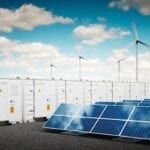Power costs from onshore wind turbines are expected to plunge 12% over the next five years due to the availability of lower-cost equipment and gains in output efficiency—and, in areas offering fair wind conditions, this could make wind power “fully competitive” with power produced from combined cycle gas turbines by 2016, new research from Bloomberg New Energy Finance shows.
The information analysis firm owned by Bloomberg Finance claims that “the best wind farms in the world already produce power as economically as coal, gas and nuclear generators.” The manufacture of onshore wind turbines displays a 7% “experience-curve”— that is a 7% cost reduction for every doubling of installed capacity—as economies of scale and supply chain efficiencies reduce costs, it says.
“Global average turbine prices have fallen in real terms from EUR 2.0m/MW in 1984 to below EUR 0.88m/MW in H1 2011. In 1984, there were only 0.3GW of installed wind capacity in the world, but by the end of 2011 there will be over 240GW,” it says.
As manufacturing costs drop, the power output achieved by onshore wind turbines as a percentage of nameplate capacity (or the capacity factor) will steadily increase. “This has been driven by the long-term move to bigger and taller turbines, better aerodynamics, better controls and gearboxes, as well as improved electrical generation efficiency,” it says. These improvements have increased capacity factors by 13 percentage points to 34% over the past 27 years.
Costs associated with operating and maintaining wind farms have also decreased in real terms—dropping from €50/MWh in the 1980s to just €11/MWh today—as operators become more experienced and the quality of turbines improves. Bloomberg New Energy Finance says that as a result of all these improvements, each megawatt of wind capacity built on land in the 1980s could be expected to deliver 1,800 MWh of electricity per year. It adds: “one megawatt of today’s more efficient and taller wind turbines can be expected to deliver 2,900 MWh each year—an impressive achievement by the industry.”
Researchers considered these factors collectively and concluded that the levelized cost of energy produced from onshore wind farms—even before subsidies or support mechanisms could be applied—had fallen by 14% for every doubling of installed capacity between 1984 and 2011.
“So the levelised cost of energy from onshore wind has fallen in 2011 real terms over this time period from EUR 200/MWh to EUR 52/MWh. This is only EUR 6/MWh more expensive than the average cost of a combined-cycle gas turbine plant in 2011,” it says. “That figure for gas-fired power excludes the cost of carbon emitted—if that were included, wind would already be at grid parity.”
The firm’s research also shows that turbine prices will continue to fall over the next few years, pegged to structural overcapacity and growing competition in the wind industry. At the same time, designers are expected to roll out even larger turbines with longer blades designed to capture more wind energy even in low-wind locations.
“These two changes will drive the cost of wind energy down further, to parity with conventional energy sources. Assuming specific learning rates for these components, we expect wind to become fully competitive with energy produced from combined-cycle gas turbines by 2016 in most regions offering fair wind conditions,” it says. “That would be the case with wind turbine prices at EUR 0.80m/MW by then. Any increase in the cost of gas, which will consequently raise the cost of energy of gas-fired turbines, would bring forward the timing of grid parity for wind.”
According to lead wind analyst at Bloomberg New Energy Finance Justin Wu, the research could dispel the “out-of-date” public perception that wind power is expensive and intermittent. Press reports about the recent drops in solar equipment costs as a result of temporary oversupply or of a trade war also mask the “long-term, consistent drop in clean energy technology costs, resulting from decades of hard work by tens of thousands of researchers, engineers, technicians and people in operations and procurement,” he said.
“And it is not going to stop: In the next few years the mainstream world is going to wake up to wind cheaper than gas, and rooftop solar power cheaper than daytime electricity. Add in the same sort of deep long-term price drops for power storage, demand management, LED lighting and so on— and we are clearly talking about a whole new game," he added.
Sources: POWERnews, Bloomberg New Energy Finance










